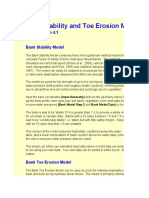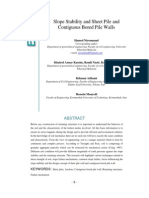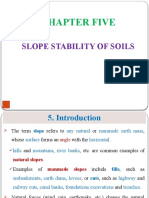Stability of Slopes
Stability of Slopes
Uploaded by
venkylovesu1Copyright:
Available Formats
Stability of Slopes
Stability of Slopes
Uploaded by
venkylovesu1Original Title
Copyright
Available Formats
Share this document
Did you find this document useful?
Is this content inappropriate?
Copyright:
Available Formats
Stability of Slopes
Stability of Slopes
Uploaded by
venkylovesu1Copyright:
Available Formats
www.android.universityupdates.in | www.universityupdates.in | https://telegram.
me/jntua
Vemu Institute of Technology Department of Civil Engineering
UNIT - IV
STABILITY OF EARTH SLOPES
SYLLABUS:
UNIT – I Stability of Slopes: Infinite and finite
earth slopes in sand and clay – types of failures –
factor of safety of infinite slopes – stability analysis
by Swedish arc method, standard method of slices
– Taylor’s Stability Number-Stability of slopes of
dams and embankments - different conditions.
Geotechnical Engineering - II 19A01701T Prof T. Murali Krishna
www.android.previousquestionpapers.com | www.previousquestionpapers.com | https://telegram.me/jntua
www.android.universityupdates.in | www.universityupdates.in | https://telegram.me/jntua
Vemu Institute of Technology Department of Civil Engineering
INTRODUCTION
The earth slope is an unsupported, inclined surface of a soil mass. The earth slopes are of two
types 1). Natural earth slopes and 2). Man made earth slopes.
The natural earth slopes are those that exist in nature and are formed by natural causes. Such
slopes exist in hilly areas. The sides of cuttings, the slopes of embankments constructed for
roads, railways lines, canals etc and the slopes of earth dams constructed for storing water are
examples of man made slopes. The figure shows some of the examples of man made earth
slopes.
The earth slopes are further classified as
1). Infinite slopes and 2). Finite slopes.
The term infinite slope is used to designate a constant slope of infinite extent. Slopes
extending to infinity do not exist in nature. An infinite slope is one which represents the
boundary surface of a semi-infinite soil mass inclined to the horizontal and having constant
soil properties for all identical depths below the surface. However in practice if the height of
the slope is very large, it may be considered as infinite slope.
A slope of limited extent, bounded by a base and a top surface is called a finite slope. The
examples of finite slopes are the inclined faces of embankments, earth dams, cuttings etc.
Geotechnical Engineering - II 19A01701T Prof T. Murali Krishna
www.android.previousquestionpapers.com | www.previousquestionpapers.com | https://telegram.me/jntua
www.android.universityupdates.in | www.universityupdates.in | https://telegram.me/jntua
Vemu Institute of Technology Department of Civil Engineering
The cost of earth work would be minimum if the earth slopes are made steepest. However
very steep slopes may not be stable. The flat earth slopes may be stable. But in flat earth slope
the cost of earth work would increases. Hence a compromise has to be made between the
economy and safety and the earth slopes provided are neither too steep nor too flat. In other
words, the steepest earth slopes which are stable and safe should be provided.
The failure of a earth slope may lead to loss of life and property. It is, therefore, essential to
check the stability of the proposed earth slopes. With the development of modern methods of
testing of soils and stability analysis, a safe and economical design of a earth slope is
possible. The geotechnical engineer should have a thorough knowledge of the various
methods for checking the stability of slopes and their limitations.
The failure of a earth slope occurs when a large mass of soil slides along a plane or a curved
surface involving a downward and outward movement of the soil mass away from the
slopping surface. The surface along which the soil mass slides when the failure of an earth
slope occurs is known as critical surface of failure.
It is evident that the failure of an earth slope occurs when the forces tending to cause the
sliding or slipping are greater than those forces tending to restore or stabilise the soil mass
along the critical surface of failure.
The sliding or slipping in a earth slope takes place mainly due to 1). The gravitational force
2). The force due to seepage water 3). Erosion of the surface of slope due to flowing water
4).The sudden lowering of water adjacent to a slope and 5). Forces due to earthquakes. The
forces which resist the failure of earth slope are shear strength of the soil and/or frictional
force, depending on the soil being cohesive or cohesionless.
The factors leading to the failure of earth slopes may be classified into two categories.
1). The factors which cause an increase in the shear stress. The shear stress in soil mass
may increase due to weight of water causing saturation of soils, surcharge loads, seepage
pressure or any other cause. The stresses are also increased due to steepening of slopes either
by excavation or by natural erosion.
2). The factors which cause an decrease in the shear strength of the soil. The loss of shear
strength of soil may occur due to an increase in the water content, increase in pore water
pressure, shock or cyclic loads, weathering or any other cause.
Most of natural slope failures occur in rainy season, as the presence of water causes both
increase in the shear stress and decrease in shear strength of soil.
Basic Assumptions in the Stability Analysis of Earth Slopes
The following assumptions are generally made in stability analysis of earth slopes.
Geotechnical Engineering - II 19A01701T Prof T. Murali Krishna
www.android.previousquestionpapers.com | www.previousquestionpapers.com | https://telegram.me/jntua
www.android.universityupdates.in | www.universityupdates.in | https://telegram.me/jntua
Vemu Institute of Technology Department of Civil Engineering
1). The soil mass is assumed as homogeneous.
2). The stress system is assumed to be two-dimensional. The stresses in the third direction
(perpendicular to the section of the soil mass) are taken as zero.
3). It is assumed that Coulomb’s equation for shear strength is applicable and the strength
parameters C and ∅ are known.
4). It is assumed that seepage conditions and water levels are known, and the corresponding
pore water pressures can be estimated.
5). The conditions of plastic failure are assumed to be satisfied along the critical surface. In
other words, the shearing strains at all points of the critical surface are large enough to
mobilise all the available shear strength.
Depending upon the method of analysis, some additional assumptions are made regarding the
magnitude and distribution of forces along various planes.
In the analysis of stability of earth slopes, the resultant of all the actuating forces trying to
cause the failure is determined. An estimate is also made on the available shear strength
trying to resist the failure. The factor of safety of the earth slope is determined from the
available resisting forces and the actuating forces.
DIFFERENT FACTORS OF SAFETY
In the stability analysis of earth slopes, the following factors of safety are normally used.
1). Factor of safety with respect to shear strength ( Fs )
The factor of safety with respect to shear strength (Fs ) is defined as the ratio of the maximum
shear strength ( s ) to the average value of mobilized shear strength ( τm).
𝑠
Thus Fs = τ𝑚
----------- (1)
Here Fs = The factor of safety with respect to shear strength
s = The maximum shear strength and
τm = The mobilised shear strength ( equal to applied shear stress )
In terms of cohesion intercept ( C ) and the angle of shear resistance ( ∅ )
The maximum shear strength = s = C + σ tan ∅ and
The mobilised shear strength = τm = Cm + σ tan ∅𝑚
Geotechnical Engineering - II 19A01701T Prof T. Murali Krishna
www.android.previousquestionpapers.com | www.previousquestionpapers.com | https://telegram.me/jntua
www.android.universityupdates.in | www.universityupdates.in | https://telegram.me/jntua
Vemu Institute of Technology Department of Civil Engineering
Here Cm = The mobilised cohesion and
∅𝑚 = The mobilised angle of shear resistance and
σ = The effective pressure
𝐶 + σ 𝑡𝑎𝑛 ∅
∴ Fs = ---------------------- ( 2 )
𝐶𝑚 + σ 𝑡𝑎𝑛 ∅𝑚
2). Factor of safety with respect to cohesion ( Fc )
The factor of safety with respect to cohesion ( Fc ) is defined as the ratio of the available
cohesion intercept ( C ) to the mobilised cohesion intercept ( Cm ).
𝐶
Thus Fc = 𝐶𝑚
-------------- ( 3 )
Here Fc = The factor of safety with respect to cohesion
C = The available cohesion intercept and
Cm = The mobilised cohesion intercept
3). Factor of safety with respect to friction ( 𝐹∅ )
The factor of safety with respect to friction (𝐹∅) is defined as the ratio of the available
frictional strength (σ tan ∅ ) to the mobilised frictional strength (σ 𝑡𝑎𝑛 ∅𝑚 ).
σ 𝑡𝑎𝑛 ∅
Thus 𝐹∅ = --------------- ( 4 )
σ 𝑡𝑎𝑛 ∅𝑚
Here 𝐹∅ = The factor of safety with respect to friction
∅ = The angle of shearing resistance and
∅𝑚 = The angle of mobilised shearing resistance
For small angles of shearing resistance the equation ( 4 ) can be expressed as
∅
𝐹∅ = ∅𝑚
--------------- ( 5 )
𝐶 + σ 𝑡𝑎𝑛 ∅
From equation ( 2 ) we have Fs =
𝐶𝑚 + σ 𝑡𝑎𝑛 ∅𝑚
Geotechnical Engineering - II 19A01701T Prof T. Murali Krishna
www.android.previousquestionpapers.com | www.previousquestionpapers.com | https://telegram.me/jntua
www.android.universityupdates.in | www.universityupdates.in | https://telegram.me/jntua
Vemu Institute of Technology Department of Civil Engineering
Rearranging the above equation we get
𝐶 + σ 𝑡𝑎𝑛 ∅
𝐶𝑚 + σ tan 𝑡𝑎𝑛 ∅𝑚 = 𝐹𝑠
𝐶 σ 𝑡𝑎𝑛 ∅
∴ 𝐶𝑚 + σ tan 𝑡𝑎𝑛 ∅𝑚 = 𝐹𝑠
+ 𝐹𝑠
−−−−−− (6)
From the above equation ( 6 ) we get
𝐶 𝐶
Cm = 𝐹𝑠
🡪 Fs = 𝐶𝑚
𝐶
But 𝐶𝑚
= The factor of safety with respect to cohesion ( Fc )
∴ Fs = Fc -------------- (7)
Similarly from equation ( 6 ) we get
σ tan𝑡𝑎𝑛 ∅
𝐹𝑠
= σ 𝑡𝑎𝑛 ∅𝑚
σ 𝑡𝑎𝑛 ∅
∴ Fs =
σ 𝑡𝑎𝑛 ∅𝑚
σ 𝑡𝑎𝑛 ∅
But
σ 𝑡𝑎𝑛 ∅𝑚
= The factor of safety with respect to friction = 𝐹∅
∴ Fs = 𝐹∅ ---------------------- ( 8 )
From equations ( 7 ) and ( 8 ) we get
Fs = F c = 𝐹∅
Therefore in the stability analysis of earth slopes, generally the three factors of safety are
taken as equal.
TYPES OF EARTH SLOPE FAILURES
The earth slope may have any one of the following failures.
1). Rotational failure.
This type of failure occurs by rotation along a slip surface by downward and outward
movement of the soil mass as shown in figure. The slip failure is generally circular for
homogeneous soil conditions and non-circular in case of non-homogeneous soil conditions.
Rotational slip failures are further sub-divided into the following three types.
Geotechnical Engineering - II 19A01701T Prof T. Murali Krishna
www.android.previousquestionpapers.com | www.previousquestionpapers.com | https://telegram.me/jntua
www.android.universityupdates.in | www.universityupdates.in | https://telegram.me/jntua
Vemu Institute of Technology Department of Civil Engineering
a). Toe failure, in which the failure occurs along the surface that passes through the toe as
shown in figure
b). Slope failure, in which the failure occurs along the surface that intersects the slope above
the toe as sown in figure.
c). Base failure, in which the failure surface passes below the toe as shown in figure.
The slope failure occurs when a weak plane exists above the toe. The base failure occurs
when a weak stratum lies beneath the toe. If a strong stratum exists below the toe, the slip
surface of the base failure is tangential to that stratum. In all other cases, the failures are toe
failures. The toe failures are most common earth slope failures.
2). Translational failure. A constant earth slope of unlimited extent and having uniform soil
properties at the same depth below the free surface is known as an infinite slope.
In practice, the earth slopes which are of considerable extent and in which the conditions on
all verticals are adequately represented by average conditions are designated as infinite
slopes.
Translational failure occurs in an infinite slope along a long failure surface parallel to the
slope as shown in figure. The shape of the failure surface is influenced by the presence of any
hard stratum at a shallow depth below the slope surface. Translational failures may also occur
along the slopes of layered materials.
Geotechnical Engineering - II 19A01701T Prof T. Murali Krishna
www.android.previousquestionpapers.com | www.previousquestionpapers.com | https://telegram.me/jntua
www.android.universityupdates.in | www.universityupdates.in | https://telegram.me/jntua
Vemu Institute of Technology Department of Civil Engineering
3). Compound failure. The compound failure is a combination of the rotational slips and
translational slips as shown in figure. A compound failure surface is curved at the two ends
and plane in the middle portion. A compound failure generally occurs when a hard stratum
exists at considerable depth below the toe.
4). Wedge failure. A failure along an inclined plane is known as plane failure or wedge
failure or block failure. It occurs when distinct blocks and wedges of the soil mass become
separated.
A plane failure is similar to translational failure in many respects. However, unlike
translational failure which occurs in an infinite slope, a plane failure may occur even in a
finite slope consisting of two different materials or in a homogeneous slope having cracks,
fissures, joints or any other specific planes of weakness.
Geotechnical Engineering - II 19A01701T Prof T. Murali Krishna
www.android.previousquestionpapers.com | www.previousquestionpapers.com | https://telegram.me/jntua
www.android.universityupdates.in | www.universityupdates.in | https://telegram.me/jntua
Vemu Institute of Technology Department of Civil Engineering
5). Miscellaneous failures. In addition to above four types of failures, some complex types
of failures in the form of spreads and flows may also occur.
Geotechnical Engineering - II 19A01701T Prof T. Murali Krishna
www.android.previousquestionpapers.com | www.previousquestionpapers.com | https://telegram.me/jntua
www.android.universityupdates.in | www.universityupdates.in | https://telegram.me/jntua
Vemu Institute of Technology Department of Civil Engineering
The Wedge Failure Stability Analysis of Finite Soil Slope
The failure along an inclined plane surface is known as wedge failure.
The wedge failure is similar to translational failure. However, the translational failure occurs
in an infinite soil slope and the wedge failure occurs in finite soil slope consisting of two
different materials or in a homogeneous slope having cracks, fissures, joints or any other
specific planes of weakness.
The wedge failure occurs when a soil slope has a specific plane of weakness. The figure
shows a finite soil slope ‘AB” subjected to wedge failure along the Plane failure surface
“AD’. In wedge failure there is a tendency of the upper mass to slide downward along the
failure plane of contact ‘AD’.
Let,
i = The angle made by the finite soil slope ‘AB” with horizontal
α = The angle made the wedge failure plane ‘AD’ with horizontal and
W = The weight of soil wedge ‘ABD’ per unit thickness
Here
The weight of soil wedge ‘ABD’ = W = γ x Volume of Soil Wedge ‘ABD’
γ = The bulk unit weight of soil
Along the plane AD, the weight of the soil wedge ( W ) can be resolved into two components
Geotechnical Engineering - II 19A01701T Prof T. Murali Krishna
www.android.previousquestionpapers.com | www.previousquestionpapers.com | https://telegram.me/jntua
www.android.universityupdates.in | www.universityupdates.in | https://telegram.me/jntua
Vemu Institute of Technology Department of Civil Engineering
1). The normal component ( N ) and
2). The tangential component ( T ).
Here a). The normal component = N = W cos α --------- (1)
b). The tangential component = T = W sin α ---------- (2)
The tangential component ‘T’ is the force causing the wedge failure of soil slope.
The maximum shearing force (S) tending to resist the wedge failure of soil slope is given by
(S)
S = C + N tan ∅ = C + (W cos α) tan ∅ ---------- (3)
Let
c = Cohesion per unit length of soil along the failure plane ‘AD” and
L = Length of failure plane ‘AD’
Here
1). Total cohesion of soil = C = c L and
2).S = cL + (W cos α) tan ∅ ---------------- (4)
Now, the factor of safety of shear strength against shear failure (FS) given by is given by
𝑀𝑎𝑥𝑖𝑚𝑢𝑚 𝑆ℎ𝑒𝑎𝑟 𝑓𝑜𝑟𝑐𝑒 𝑟𝑒𝑠𝑖𝑠𝑡𝑖𝑛𝑔 𝑡ℎ𝑒 𝑓𝑎𝑖𝑙𝑢𝑟𝑒 𝑆 𝑐𝐿 + (𝑊 𝑐𝑜𝑠 α) 𝑡𝑎𝑛 ∅
Fs = 𝑆ℎ𝑒𝑎𝑟 𝑓𝑜𝑟𝑐𝑒 𝑐𝑎𝑢𝑠𝑖𝑛𝑔 𝑡ℎ𝑒 𝑓𝑎𝑖𝑙𝑢𝑟𝑒
== 𝑇
= 𝑊 𝑠𝑖𝑛 α
--------------- (4)
The Culmann’s Method of Stability Analysis of Finite Soil Slope
Geotechnical Engineering - II 19A01701T Prof T. Murali Krishna
www.android.previousquestionpapers.com | www.previousquestionpapers.com | https://telegram.me/jntua
www.android.universityupdates.in | www.universityupdates.in | https://telegram.me/jntua
Vemu Institute of Technology Department of Civil Engineering
The Culmann’s method is used for the approximate stability analysis of homogeneous finite
soil slopes. In this method a plain failure surface passing through the toe is assumed. A plain
failure surface is not a correct assumption for a homogeneous soil. However, it is a simple
failure mechanism and is described for purpose of illustration and for determination of the
approximate value of the factor of safety.
Let us consider the equilibrium of the triangular soil wedge ‘ABD’ formed by the inclined
soil slop surface ‘AB’ and the assumed plane failure surface ‘AD’ as shown in figure.
Let i = The angle made by the inclined soil surface ‘AB’ with horizontal and
α = The angle made by the plane failure surface ‘AD’ with horizontal
Cm = The total mobilised cohesive force acting on the failure surface ‘AD’
L = The length of plane failure surface ‘AD’ and
H = The vertical height of inclined soil surface ‘AB’
From the diagram
𝐻 𝐻
Cos (900 – i) = 𝐴𝐵
Sin i = 𝐴𝐵
𝐻
∴ 𝐴𝐵 = 𝑖
Geotechnical Engineering - II 19A01701T Prof T. Murali Krishna
www.android.previousquestionpapers.com | www.previousquestionpapers.com | https://telegram.me/jntua
www.android.universityupdates.in | www.universityupdates.in | https://telegram.me/jntua
Vemu Institute of Technology Department of Civil Engineering
Stability Analysis of Finite Slopes
The finite slope is bounded by a base and a top surface. The unlined inclined faces of earth
dams. embankments, excavations etc., are all finite slopes. Thus, the stability analysis of
finite slope is of vital importance for civil engineers.
The failure of finite slopes occurs along a curved surface. In stability analysis of finite slopes
the curved failure surface is usually replaced by an arc of a circle or a logarithmic spiral.
Two basic types of failure of a finite slope may occur : 1). Slope failure 2). Base failure
1). Slope failure
If the failure occurs along a surface of sliding or a surface of slippage that intersects the slope
at or above the toe is known as slope failure.
The slope failure is called a face failure if the failure surface passes above the toe.
The slope failure is called a toe failure if the failure surface passes through the toe.
2). Base failure
If the soil beneath the toe of the slope is weak, the failure occurs along a surface that passes at
some distance below the toe of the slope. Such a type of failure is called base failure.
The slope failure and the base failure of finite slopes are as shown in figure.
The ratio of the total depth ‘(H+D)’ to the depth ‘H’ is known as ‘Depth factor (Df)’.
𝐻+𝐷
The depth factor = Df = 𝐻
For toe failure Df = 1 and for base failure Df >1.
Geotechnical Engineering - II 19A01701T Prof T. Murali Krishna
www.android.previousquestionpapers.com | www.previousquestionpapers.com | https://telegram.me/jntua
www.android.universityupdates.in | www.universityupdates.in | https://telegram.me/jntua
Vemu Institute of Technology Department of Civil Engineering
The stability analysis of finite slopes involves the following steps
1). Assuming a possible slip surface or failure surface.
2). Studying the equilibrium of the forces acting on this surface and determine the factor of
safety
3). Repeating the procedure until the worst slip surface, for which minimum factor of safety,
is found.
The stability of finite slopes can be analysed by a number of methods. The following methods
are commonly adopted.
1). The Friction circle method.
2). The Taylor’s method..
3). The Swedish circle method.
Geotechnical Engineering - II 19A01701T Prof T. Murali Krishna
www.android.previousquestionpapers.com | www.previousquestionpapers.com | https://telegram.me/jntua
www.android.universityupdates.in | www.universityupdates.in | https://telegram.me/jntua
Vemu Institute of Technology Department of Civil Engineering
4). The Bishop’s method.
The ∅𝑢 = 0 analysis
In case of fully saturated clays under undrained conditions, the stability of slopes can be
checked in terms of total stresses. Such a condition can occurs in soil slopes immediately
after construction. In this case ∅𝑢 = 0 and c = cu.
The failure surface is assumed to be a circular arc ‘AB’. The figure shows a failure surface
with centre ‘O’ and radius ‘r’. The weight ‘W’ above the failure surface causes the instability.
For equilibrium, the shear stress to be mobilised along the failure surface can be expressed as
𝑠 𝑐𝑢
τ𝑚 = 𝐹
= 𝐹
-------- (1)
Here τ𝑚 = The mobilised shear stress along the failure surface ‘AB’
s = The shear strength of soil = cu and
F = The factor of safety.
Now, by taking the moments about the centre ‘O’, we get
W x d = τ𝑚 x La x r --------------- (2)
2π𝑟θ
Here La = The length of circular arc ‘AB’ = 0 and
360
d = The lever arm of weight ‘W’ about the centre ‘O’
Substituting equation (1) in equation (2), we get
𝑐𝑢
W x d = 𝐹 x La x r
𝑐𝑢 𝐿𝑎 𝑟
∴ F = 𝑊 𝑥 𝑑 -------------- (3)
Geotechnical Engineering - II 19A01701T Prof T. Murali Krishna
www.android.previousquestionpapers.com | www.previousquestionpapers.com | https://telegram.me/jntua
www.android.universityupdates.in | www.universityupdates.in | https://telegram.me/jntua
Vemu Institute of Technology Department of Civil Engineering
If a tension crack develops and water enters the crack, the hydrostatic force ‘Pw’ acts on the
portion ‘BC’ of the arc at a height of ‘h/3’ from ‘C’. Here ‘h’ is the depth of the tension
crack.
𝑐
The depth of tension crack is given by h = 2 γ
The effect of tension crack is to shorten the length of failure surface along which the shearing
resistance gets mobilised to ‘AC’.
In this case the arc length ‘La’ is equal to ‘AC’.
UNIT – V
EARTH RETAINING STRUCTURES
Geotechnical Engineering - II 19A01701T Prof T. Murali Krishna
www.android.previousquestionpapers.com | www.previousquestionpapers.com | https://telegram.me/jntua
You might also like
- California LLP Operating Agreement-ArchitectsDocument9 pagesCalifornia LLP Operating Agreement-Architectscallegalforms100% (2)
- C3 Slope StabilityDocument54 pagesC3 Slope StabilityLeo LaiNo ratings yet
- Ito MatsuiDocument11 pagesIto MatsuiDoinea MihailNo ratings yet
- Notes 1 - Shear StrengthDocument57 pagesNotes 1 - Shear StrengthMohamedAjmuzshanNo ratings yet
- Chapter 4Document14 pagesChapter 4Yen Ling NgNo ratings yet
- Lecture5 - Slope StabilityDocument51 pagesLecture5 - Slope StabilityJoseph Baruhiye100% (1)
- Slope Stabillity Analysis & Its StabillisationDocument20 pagesSlope Stabillity Analysis & Its StabillisationakurilNo ratings yet
- Mechanically Stabilized Earth: From Wikipedia, The Free Encyclopedia Jump ToDocument13 pagesMechanically Stabilized Earth: From Wikipedia, The Free Encyclopedia Jump Tosnow_smoothiesNo ratings yet
- Estabilizacion de TaludesDocument8 pagesEstabilizacion de Taludesmiguel moralesNo ratings yet
- Chapter4-Slope StabilityDocument14 pagesChapter4-Slope StabilityjemalahmedusaayNo ratings yet
- Seismic Stability Assessment of An Existent CountermeasureDocument8 pagesSeismic Stability Assessment of An Existent CountermeasureFirat PulatNo ratings yet
- Shear Strength of Soil Part 1 PDFDocument53 pagesShear Strength of Soil Part 1 PDFVal GallanoNo ratings yet
- Chapter 3 Design of Shallow FoundatinDocument30 pagesChapter 3 Design of Shallow FoundatinYIBELTAL EBABU100% (2)
- Chapter1 PDFDocument21 pagesChapter1 PDFabimanaNo ratings yet
- Factor of Safety of A Consolidated SlopeDocument33 pagesFactor of Safety of A Consolidated SlopeMadan RamuNo ratings yet
- Engr. John Michael GargulloDocument4 pagesEngr. John Michael GargulloHendrix Rivera OrtegaNo ratings yet
- Slope Stability in Expansive SoilsDocument35 pagesSlope Stability in Expansive SoilsyidNo ratings yet
- Bank Stability and Toe Erosion Model: Static Version 4.1Document46 pagesBank Stability and Toe Erosion Model: Static Version 4.1Mohamad HartadiNo ratings yet
- SlopeDocument33 pagesSlopeMuhammadImranShahzad100% (1)
- 1023-TRAC-CI-RPT-001 - 2 - IFR-Preliminary Design of Dyke WallDocument18 pages1023-TRAC-CI-RPT-001 - 2 - IFR-Preliminary Design of Dyke WallARUN RAWATNo ratings yet
- 3.7 Factors of Safety For SlidingDocument5 pages3.7 Factors of Safety For SlidingSushil DhunganaNo ratings yet
- Soil Forces and Single-Wedge Sliding Analysis: EM 1110-2-2100 1 Dec 05Document14 pagesSoil Forces and Single-Wedge Sliding Analysis: EM 1110-2-2100 1 Dec 05ibrahimNo ratings yet
- Chapter 10 Slope StabilityDocument54 pagesChapter 10 Slope Stabilityhare krishna91% (11)
- CE-8491-UNIT-4 Watermark Watermark Watermark CompressDocument38 pagesCE-8491-UNIT-4 Watermark Watermark Watermark Compressgameface.gamerNo ratings yet
- Drahmedsoil Mechanicsnoteschapter 6Document54 pagesDrahmedsoil Mechanicsnoteschapter 6Burak YeşilNo ratings yet
- Notes On Topic 2 - Slope Stability Notes On Topic 2 - Slope StabilityDocument32 pagesNotes On Topic 2 - Slope Stability Notes On Topic 2 - Slope StabilityshivaNo ratings yet
- Slope Stability Analysis of An Earth Dam: Diyala Journal of Engineering Sciences March 2017Document13 pagesSlope Stability Analysis of An Earth Dam: Diyala Journal of Engineering Sciences March 2017inam.emadi2No ratings yet
- Chapter 1Document21 pagesChapter 1tilayeyidegNo ratings yet
- Ppr12 322alrDocument19 pagesPpr12 322alrgabemzamanNo ratings yet
- FGE-II-Lecture 5 ABDocument68 pagesFGE-II-Lecture 5 ABmegersatolasaNo ratings yet
- Unconfined Compression TestDocument9 pagesUnconfined Compression TestAyman SobhyNo ratings yet
- C3 Slope StabilityDocument89 pagesC3 Slope StabilitySara LaiNo ratings yet
- b80f PDFDocument10 pagesb80f PDFMirza Waqar BaigNo ratings yet
- Lecture NotesDocument212 pagesLecture NotesRishi Nath100% (1)
- Soil Mechanics (Shear Strength of Soil)Document16 pagesSoil Mechanics (Shear Strength of Soil)VEERKUMARNo ratings yet
- ch1 Soil MechanicsDocument19 pagesch1 Soil MechanicsBN NGNo ratings yet
- CE 415c - Module 3Document7 pagesCE 415c - Module 3Johnny King ReyesNo ratings yet
- NOTA KURSUS TAHUN 2006 - Analisa Kesetabilan Cerun Dan Rekabentuk Tembok Penahan - 16-05-2006Document157 pagesNOTA KURSUS TAHUN 2006 - Analisa Kesetabilan Cerun Dan Rekabentuk Tembok Penahan - 16-05-2006Amnee HalimNo ratings yet
- 05 Circular FailureDocument16 pages05 Circular FailureMuhammed AmmachandyNo ratings yet
- 2000 07Document15 pages2000 07chithirai10No ratings yet
- Application of Forces Acting On Jetty StructureDocument9 pagesApplication of Forces Acting On Jetty StructureIJSTENo ratings yet
- Design of Underground Structures Under Seismic Conditions: A Long Deep Tunnel and A Metro TunnelDocument37 pagesDesign of Underground Structures Under Seismic Conditions: A Long Deep Tunnel and A Metro TunnelClinton DameNo ratings yet
- Chapter Five: Slope Stability of SoilsDocument58 pagesChapter Five: Slope Stability of SoilshannaNo ratings yet
- Ch11 SlopeDocument20 pagesCh11 SlopehanumabendadiNo ratings yet
- 6 Evaluation of Slope StabilityDocument17 pages6 Evaluation of Slope StabilitytsuakNo ratings yet
- Flac Blast LoadDocument4 pagesFlac Blast LoadKaram MiniNo ratings yet
- Unit 2 StabilityDocument21 pagesUnit 2 StabilityjatinsaiwaltechnoxNo ratings yet
- DR Ahmed Soil Mechanics Notes Chapter 6Document54 pagesDR Ahmed Soil Mechanics Notes Chapter 6COMEDY NEPALNo ratings yet
- 2 Chapter General Bearing Capacity FinalDocument30 pages2 Chapter General Bearing Capacity FinalYousif MawloodNo ratings yet
- Lesson 5 Excavations and Excavation SupportsDocument15 pagesLesson 5 Excavations and Excavation SupportsRsjBugtong100% (1)
- Application of Genetic Algorithm in Slope Stability AnalysisDocument14 pagesApplication of Genetic Algorithm in Slope Stability Analysismanojsharma7466No ratings yet
- Seismic Vulnerability Indices For Ground and Structures Using MicrotremorDocument7 pagesSeismic Vulnerability Indices For Ground and Structures Using MicrotremorMiguel AngelNo ratings yet
- Strengthening System Effects On The Out-Of-Plane Mechanisms Activation of Masonry Walls Under Tsunami LoadsDocument24 pagesStrengthening System Effects On The Out-Of-Plane Mechanisms Activation of Masonry Walls Under Tsunami LoadsmohamedNo ratings yet
- 2017 Geotechnique 67 7 608 620 Cocjin Et Al PDFDocument40 pages2017 Geotechnique 67 7 608 620 Cocjin Et Al PDFPaypal BusinessNo ratings yet
- C3 Slope StabilityDocument41 pagesC3 Slope Stability2499361939wNo ratings yet
- Fault Zone Dynamic Processes: Evolution of Fault Properties During Seismic RuptureFrom EverandFault Zone Dynamic Processes: Evolution of Fault Properties During Seismic RuptureMarion Y. ThomasNo ratings yet
- Cover Letter For Visa Application SingaporeDocument7 pagesCover Letter For Visa Application Singaporetvanfdifg100% (2)
- MOS Unit 05 zOSDocument45 pagesMOS Unit 05 zOSSEENIVASNo ratings yet
- Uflex Packaging StartegyDocument91 pagesUflex Packaging StartegyRahul Jamdagni100% (1)
- Risk Mitigation PlanDocument3 pagesRisk Mitigation Plansuryakrish krishnanNo ratings yet
- Masterseal 953 TdsDocument2 pagesMasterseal 953 TdspaulaNo ratings yet
- Aurora 8b10b Protocol Spec Sp002Document78 pagesAurora 8b10b Protocol Spec Sp002Anonymous oCWk8jcz7kNo ratings yet
- 17 Santos Vs NLRCDocument4 pages17 Santos Vs NLRCImariNo ratings yet
- Chapter 4 - Introduction To Source Coding PDFDocument72 pagesChapter 4 - Introduction To Source Coding PDFGnitNo ratings yet
- Suz-Ka25-71va2 Service Manual (Och472a)Document74 pagesSuz-Ka25-71va2 Service Manual (Och472a)Chi Phạm HồngNo ratings yet
- Resume: Name: Bhuwan Vohra Mob: 9068291781 Career ObjectiveDocument2 pagesResume: Name: Bhuwan Vohra Mob: 9068291781 Career ObjectiveBhuwan VohraNo ratings yet
- PdfexDocument3 pagesPdfexanon-137807No ratings yet
- Sr5500 SpecsDocument2 pagesSr5500 SpecsCauê GodoyNo ratings yet
- Service Manual Service Manual: Gn2SkDocument224 pagesService Manual Service Manual: Gn2SkClubedoTecnicoNo ratings yet
- Learning Chinese in The Digital Age Celin Brief Edu enDocument15 pagesLearning Chinese in The Digital Age Celin Brief Edu enXerxes BreakNo ratings yet
- Thermodynamic Process Tutorial 4 1Document2 pagesThermodynamic Process Tutorial 4 1Boon Khai ChienNo ratings yet
- Numismatics - An Art and Investment.Document4 pagesNumismatics - An Art and Investment.Suresh Kumar manoharanNo ratings yet
- Samsung sm-r210 PDFDocument51 pagesSamsung sm-r210 PDFJavier RuedasNo ratings yet
- Assignment 3Document4 pagesAssignment 3kietNo ratings yet
- 8508 8509 8510 Bulletin REDocument4 pages8508 8509 8510 Bulletin REChristian DeleonNo ratings yet
- Psychic Intuitive Management For Our Modern AgeDocument20 pagesPsychic Intuitive Management For Our Modern AgeCommercial ScoutsNo ratings yet
- June 2008 Ms 6002Document19 pagesJune 2008 Ms 6002Shifana ARNo ratings yet
- CH2021221000927 FatDocument4 pagesCH2021221000927 FatVijayakumar SindhuNo ratings yet
- Astro Hog Flying Instructions by Fred DunnDocument2 pagesAstro Hog Flying Instructions by Fred DunnRicardo SalazarNo ratings yet
- SRODocument17 pagesSROPayas TalwarNo ratings yet
- Business Tax - Sat Prelim - 2ND Sem - 2019-2020Document4 pagesBusiness Tax - Sat Prelim - 2ND Sem - 2019-2020Renalyn ParasNo ratings yet
- Code of Ethics For Professional Teachers: Arlene R. Remulla & Christien P. LeynesDocument23 pagesCode of Ethics For Professional Teachers: Arlene R. Remulla & Christien P. LeynesHarold AbutNo ratings yet
- Roundhill OfstedDocument8 pagesRoundhill OfstedJatinder PablaNo ratings yet
- Laser Communication: Mini Project ReportDocument15 pagesLaser Communication: Mini Project ReportPrasannaKumarReddyKaturuNo ratings yet
- Amigurumi 294spike The DinosaurDocument5 pagesAmigurumi 294spike The DinosaurDra. Alejandra De la Fuente100% (4)

























































































